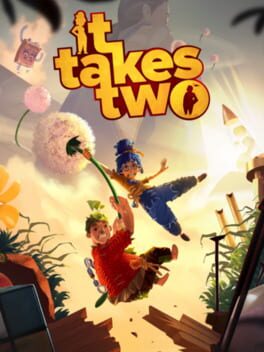Weepboop
BACKER
625 Reviews liked by Weepboop
NOTE: This rating heavily influenced by nostalgia. Would give 4.25 if I could
Pros:
Music
Aesthetic
Characters
10/10 localization
Voice Acting
Subtle queer vibes on so many of the characters without actually making it a plot point
Lots of postgame content
Cons:
Boss fights are kinda wonky and button mashy with little real strategy
Enemy variety is lacking
The "change your fate" mechanic feels like unnecessary padding
The plot isn't as brave as the first and feels a little weird, pacing-wise, but still fun
100%ing the game is a little TOO grindy
Pros:
Music
Aesthetic
Characters
10/10 localization
Voice Acting
Subtle queer vibes on so many of the characters without actually making it a plot point
Lots of postgame content
Cons:
Boss fights are kinda wonky and button mashy with little real strategy
Enemy variety is lacking
The "change your fate" mechanic feels like unnecessary padding
The plot isn't as brave as the first and feels a little weird, pacing-wise, but still fun
100%ing the game is a little TOO grindy
NieR: Automata
2017
Yakuza Kiwami
2016
Metal Gear Solid
1998
It Takes Two
2021
It Takes Two
2021
Sea of Thieves
2018
Doom Eternal
2020
Doom Eternal has enjoyed a highly positive reception, but there’s been an ongoing controversy regarding the game’s Marauder enemies. They’re by far the most complex enemies and mirror many of the players’ own skills, so as soon one enters the fray, the demon-slaying power fantasy becomes a tense duel to the death. Such a common action game trope hardly seems worthy of debate, but the counterargument is that they hurt the pace enough to where the free-flowing core of the combat breaks down entirely. With the Marauder seizing control of the battle with his speed and persistence, players can’t comfortably glory kill other enemies for health, use the chainsaw for ammo, or switch their focus to other enemies. They instead have to follow the very specific instructions given to them in a pop-up tutorial, which I will quote in full:
The Marauder is a defensive powerhouse.
Stand too close, he uses his Shotgun.
Stand too far away, he throws projectiles.
Keep him at mid-range, counter his attack when his eyes flash green; otherwise, he blocks your shots.
The Marauder is resistant to Super Weapons.
This “butter-zone” between standing too near or far is an incredibly hard thing to balance, especially when being chased and blasted with attacks, so it’s easy to sympathize with players who struggle with it. It’s also easy to sympathize with the expert players who have no trouble at all, because they don’t even need to follow those guidelines. In fact, no one does, because those instructions are incomplete at best, and completely misleading at worst. Players can instead just stagger the Marauder as he charges with his axe, and chain it with another powerful blast as he stumbles for even more damage. So why don’t players just do this instead?
The best way to explain why is by comparing the Marauder to the other enemies in the game, with a great example being the Cacodemon. Its pop-up tutorial states the following:
The Cacodemon is a Pressure Demon with a powerful close-range bite.
If you can fire a Sticky Bomb or Frag Grenade into its mouth, it instantly Staggers.
This stagger is not only a 100% consistent glory-kill setup, it’s inarguably the most efficient way to take down these enemies. Since grenades operate on a cooldown instead of ammunition capacity, and the ammo requirement from other weapons can be high, the strong majority of Cacodemons killed in the average playthrough will be through the tooltip’s grenade-glory double tap. Other tutorials are fairly comparable: players are told to shoot the armor off Mancubi, the guns off Revenants and Arachnotrons, to hit the back of the Pinkies, and so on. While these are useful hints, they communicate a worrying precedent to the player that the strategy outlined by the tooltip is what you should always try to do. By having information spoon-fed before the enemy is even visible on screen, players are being trained to turn their brain off and follow the instructions. Another good point of comparison would be the Shield Soldier, the other enemy in the game who prominently uses an energy shield to block the player’s shots. They’re common enemies, so players will be used to chainsawing through them, throwing explosives behind them, or just using the BFG. If you use these same strategies against the Marauder however, none of them will work, which isn’t a problem in itself, but it fits the pattern of Doom Eternal’s poorly handled conveyance.
Put simply, conveyance is how a game communicates its rules to the player, and this is the heart of what the real problem is. The Marauder is simply where it came to a head, where a misleading tutorial collided with players disincentivized to think critically, thanks to a series of patronizing explanations of dominant strategies. The easy answer may be to just turn them off, but when disabling that setting also turns off help for how contextual gimmicks work, there’s no good solution. The combat has also been balanced around the player knowing these tips and using the dominant strategies they outline, weighing down the player’s capacity for mechanical expressiveness. It's not just the Marauder that's impacted, the player's entire mentality when engaging with enemies suffers from the rigidity of this design. It makes sense that with all the new features in Doom Eternal, the developers wanted to tie enemies to specific mechanics to ensure their use, but depth isn’t just a measure of how many decisions a player could make, but how many they’re actively incentivized to make.
If players only require an active sense of incentive though, doesn’t that bring us into a paradox, where the Marauder’s poor tutorial, and hidden better strategy, could be seen as an incentive for players to think for themselves? It may seem like I’m contradicting myself by acknowledging that’s how certain players will see it, but when games are such subjective experiences, analysis can only go as far as the positive and negative reinforcements that affect players on a general level. There are lots of Doom fans who will rise to the challenge like this and have an amazing time experimenting with the crazy amount of toys the game lets you play with, but the majority of players won’t bother to put in the effort unless prodded to do so. With fewer explicit tutorials and combat based around a more flexible variety of ways to counter enemies in general, players would be primed to test their entire arsenal against each new enemy and experience the joy of mechanical discovery action games are all about.
The Marauder is a defensive powerhouse.
Stand too close, he uses his Shotgun.
Stand too far away, he throws projectiles.
Keep him at mid-range, counter his attack when his eyes flash green; otherwise, he blocks your shots.
The Marauder is resistant to Super Weapons.
This “butter-zone” between standing too near or far is an incredibly hard thing to balance, especially when being chased and blasted with attacks, so it’s easy to sympathize with players who struggle with it. It’s also easy to sympathize with the expert players who have no trouble at all, because they don’t even need to follow those guidelines. In fact, no one does, because those instructions are incomplete at best, and completely misleading at worst. Players can instead just stagger the Marauder as he charges with his axe, and chain it with another powerful blast as he stumbles for even more damage. So why don’t players just do this instead?
The best way to explain why is by comparing the Marauder to the other enemies in the game, with a great example being the Cacodemon. Its pop-up tutorial states the following:
The Cacodemon is a Pressure Demon with a powerful close-range bite.
If you can fire a Sticky Bomb or Frag Grenade into its mouth, it instantly Staggers.
This stagger is not only a 100% consistent glory-kill setup, it’s inarguably the most efficient way to take down these enemies. Since grenades operate on a cooldown instead of ammunition capacity, and the ammo requirement from other weapons can be high, the strong majority of Cacodemons killed in the average playthrough will be through the tooltip’s grenade-glory double tap. Other tutorials are fairly comparable: players are told to shoot the armor off Mancubi, the guns off Revenants and Arachnotrons, to hit the back of the Pinkies, and so on. While these are useful hints, they communicate a worrying precedent to the player that the strategy outlined by the tooltip is what you should always try to do. By having information spoon-fed before the enemy is even visible on screen, players are being trained to turn their brain off and follow the instructions. Another good point of comparison would be the Shield Soldier, the other enemy in the game who prominently uses an energy shield to block the player’s shots. They’re common enemies, so players will be used to chainsawing through them, throwing explosives behind them, or just using the BFG. If you use these same strategies against the Marauder however, none of them will work, which isn’t a problem in itself, but it fits the pattern of Doom Eternal’s poorly handled conveyance.
Put simply, conveyance is how a game communicates its rules to the player, and this is the heart of what the real problem is. The Marauder is simply where it came to a head, where a misleading tutorial collided with players disincentivized to think critically, thanks to a series of patronizing explanations of dominant strategies. The easy answer may be to just turn them off, but when disabling that setting also turns off help for how contextual gimmicks work, there’s no good solution. The combat has also been balanced around the player knowing these tips and using the dominant strategies they outline, weighing down the player’s capacity for mechanical expressiveness. It's not just the Marauder that's impacted, the player's entire mentality when engaging with enemies suffers from the rigidity of this design. It makes sense that with all the new features in Doom Eternal, the developers wanted to tie enemies to specific mechanics to ensure their use, but depth isn’t just a measure of how many decisions a player could make, but how many they’re actively incentivized to make.
If players only require an active sense of incentive though, doesn’t that bring us into a paradox, where the Marauder’s poor tutorial, and hidden better strategy, could be seen as an incentive for players to think for themselves? It may seem like I’m contradicting myself by acknowledging that’s how certain players will see it, but when games are such subjective experiences, analysis can only go as far as the positive and negative reinforcements that affect players on a general level. There are lots of Doom fans who will rise to the challenge like this and have an amazing time experimenting with the crazy amount of toys the game lets you play with, but the majority of players won’t bother to put in the effort unless prodded to do so. With fewer explicit tutorials and combat based around a more flexible variety of ways to counter enemies in general, players would be primed to test their entire arsenal against each new enemy and experience the joy of mechanical discovery action games are all about.
Disco Elysium
2019
Can't remember the last game I was so enamored by like this. Gets a little tedious when approaching the end game, but that could be cause I tried to tie up most the loose ends and see everything possible. Comes back around with an amazing callback (if you internalize a certain Thought) and a pretty satisfying ending. Really fucking funny game too.
Tales of Berseria
2016
I didn't like Tales of Berseria very much at all.
The story is very melodramatic and the characters are fairly standard JRPG fare. I didn't find a lot to like (or really even understand) in any of their motivations. Feels like the characters were designed and then shoehorned into the story, rather than having an actual part to play.
The world itself is pretty generic with a group of people that are "demons" who arbitrarily have supernatural abilities and are hunted/enslaved by humans. This is conveyed with a lot of jargony lore, which people in game talk about as though it makes sense (similar to FF13), without much that is compelling or even understandable going on to make me care.
Combat doesn't stray too far from what has been established in past Tales games.
The game presents a bunch of combat options (custom combos, exploiting weaknesses, guarding and guard breaks, etc...) but engaging in those systems isn't that necessary or rewarding, so combat just ends up feeling very spammy.
This is on top of the fact that the combat itself lacks impact and feels floaty and unresponsive.
I found myself feeling like I was missing something fundmental, but also spamming my way through fights without any problems.
The world is high contrast and can be visually appealing at times, but is mostly fairly boring and generic. The few dungeons I played also were just unengaging, with puzzles that didn't make much sense or have much coherency.
Similar to my past experiences with Tales of.. games, I ended up just not having much reason to continue playing, so I dropped this one pretty quickly.
The story is very melodramatic and the characters are fairly standard JRPG fare. I didn't find a lot to like (or really even understand) in any of their motivations. Feels like the characters were designed and then shoehorned into the story, rather than having an actual part to play.
The world itself is pretty generic with a group of people that are "demons" who arbitrarily have supernatural abilities and are hunted/enslaved by humans. This is conveyed with a lot of jargony lore, which people in game talk about as though it makes sense (similar to FF13), without much that is compelling or even understandable going on to make me care.
Combat doesn't stray too far from what has been established in past Tales games.
The game presents a bunch of combat options (custom combos, exploiting weaknesses, guarding and guard breaks, etc...) but engaging in those systems isn't that necessary or rewarding, so combat just ends up feeling very spammy.
This is on top of the fact that the combat itself lacks impact and feels floaty and unresponsive.
I found myself feeling like I was missing something fundmental, but also spamming my way through fights without any problems.
The world is high contrast and can be visually appealing at times, but is mostly fairly boring and generic. The few dungeons I played also were just unengaging, with puzzles that didn't make much sense or have much coherency.
Similar to my past experiences with Tales of.. games, I ended up just not having much reason to continue playing, so I dropped this one pretty quickly.













